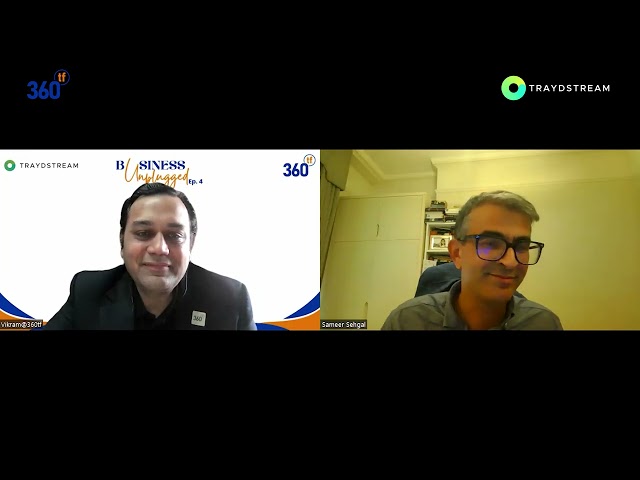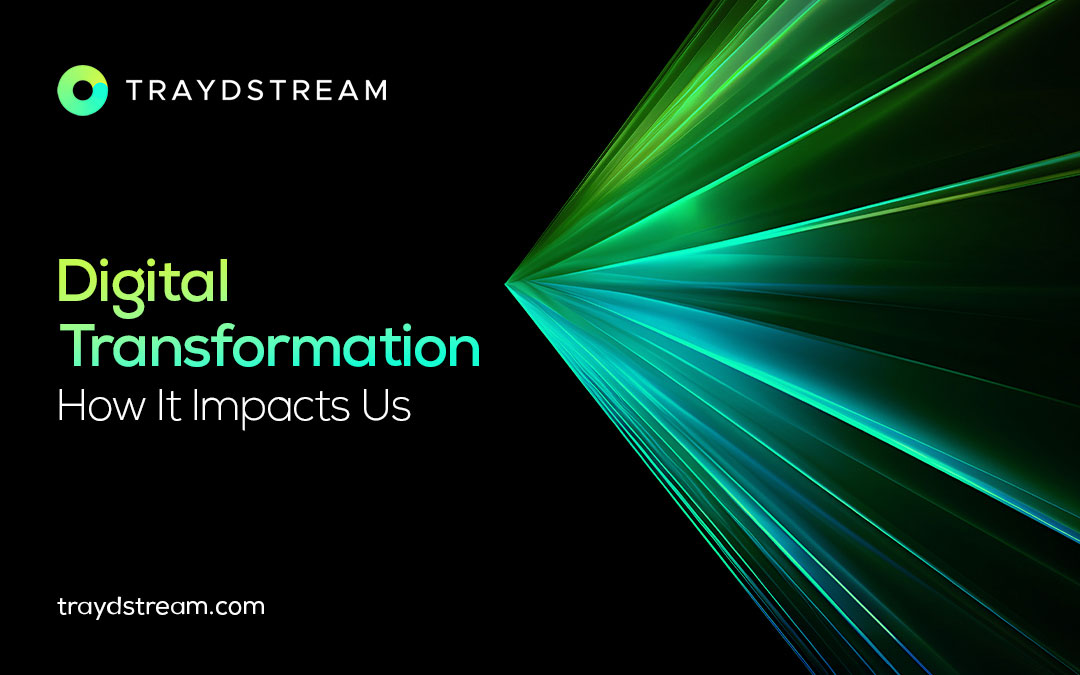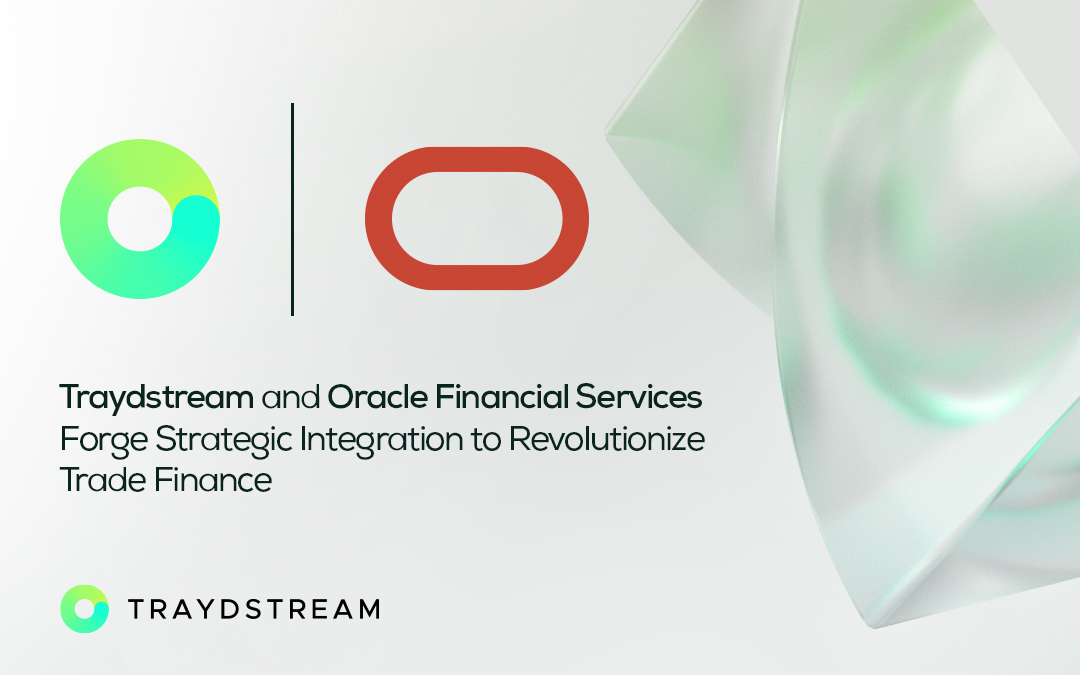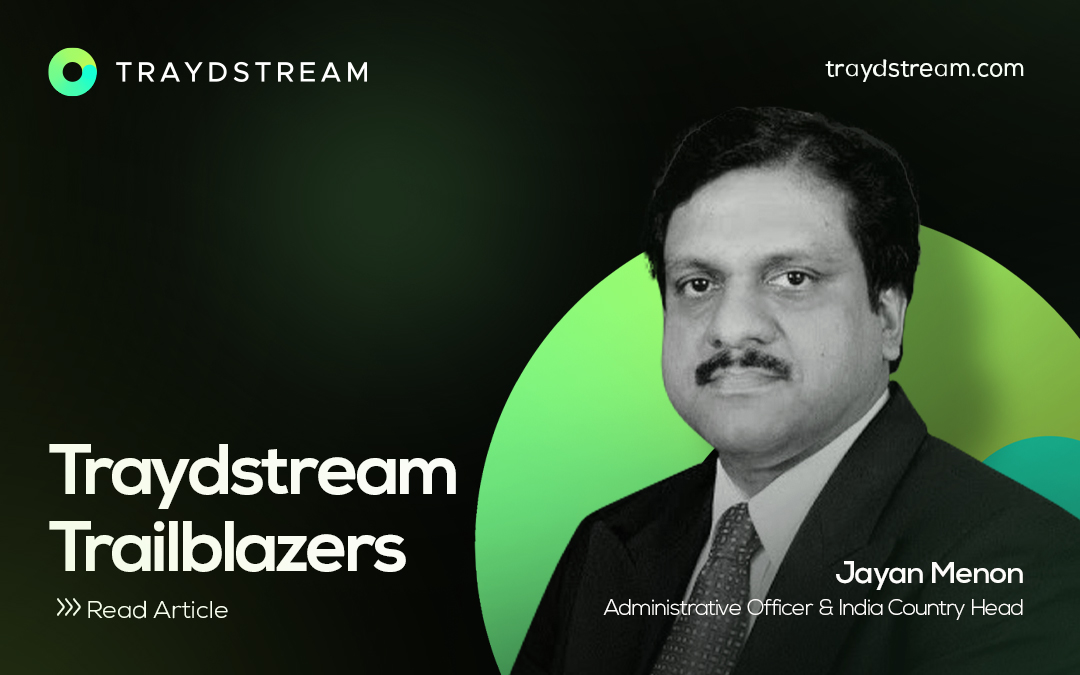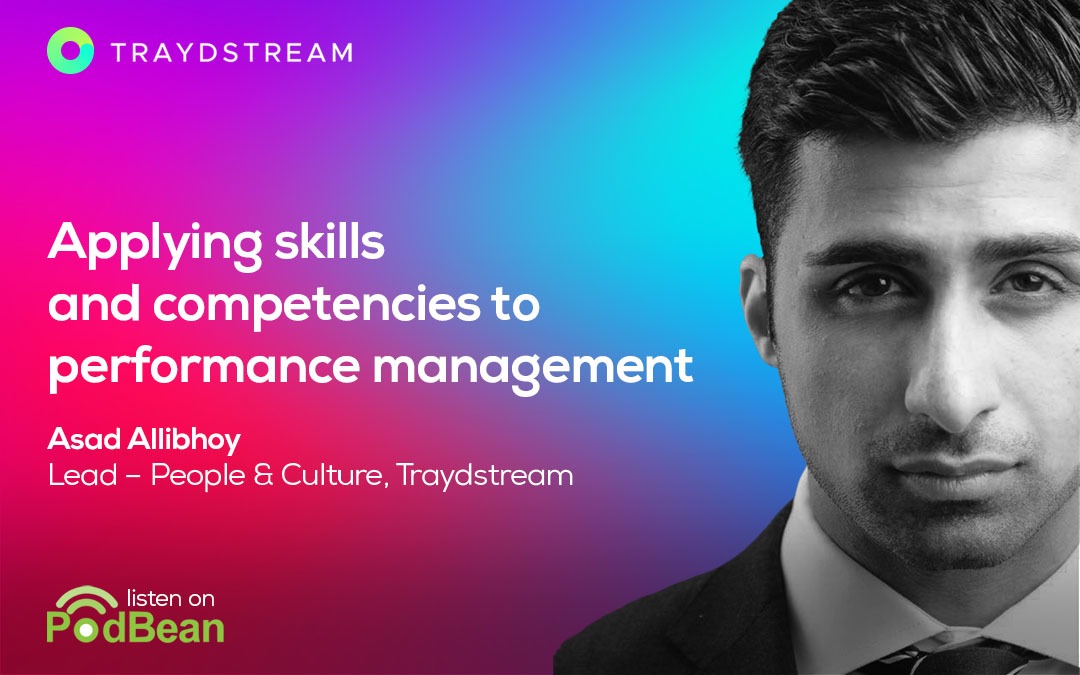
Interviewer: Dan van der Werf
Interviewee: Asad Allibhoy
Dan: Welcome to our Skills of the Future podcast. Our theme for the series is HR game changers applying skills and competencies to the world of work. My name is Dan van der Werf. I’m principal consultant and co-founder at Perennial Talent. In this episode, I will be talking to Asad Allibhoy about applying skills and competencies to performance management. Asad joins us from Toronto, Canada.
Today he is the People and Culture Lead for Traydstream – which is a rapidly growing fintech based in the UK. Asad oversees the talent management strategy and operations ranging from: talent acquisition, talent intelliegence, and talent development for almost 120 employees across four continents. Through Asad’s time in advertising, management consulting, private equity and technology, he has grown a passion for data analytics, problem solving methodologies and servant leadership.
He aspires to create a meritocratic, collaborative, and sustainable operating model that will create a platform to transform today’s talent transform into tomorrow’s leaders. Asad I’m so pleased to have you on today. How are you doing today?
Asad: I’m doing well, Dan. Thanks for asking and I really appreciate you having me here today. It’s really a pleasure and honour to be here. I’m personally very excited to sit down and talk to you about talent. I believe it’s a topic we are both deeply passionate about.
Dan: I’m excited to have you and see how the conversation plays out today, so I thought to get the conversation started we’ll start with a fun icebreaker-type question. I know given the pandemic, I’ve been reading and watching Netflix more than usual so I thought I’d see if you have any recommendations on anything that you’ve read or watched lately.
Asad: Yeah! So the last book I read – and it was hard to put down – was 11 Rings by Phil Jackson. He is arguably the greatest coach in the history of the NBA; he managed Jordan during that crazy ‘89 – 98’ tenure. And then he went on to manage the Lakers from 2000 to 2010. He’s had the pleasure and pressure of managing some of the most talented players in the sports’ history – you know, Michael Jordan, Kobe Bryant.
The book highlights his guiding principles and a plethora of winning methodologies and how to create a high-performance culture that focuses on creating a mindset of continuous improvement, which leads to a winning mindset, and then how to create this balanced harmony within teams. I highly recommend it.
Dan: Yeah that’s awesome, I might have to check that out! It sounds like a nice balance of like entertainment but also useful information that you can apply to work as well.
Asad: Yeah, he’s got some locker room secrets, and it’s also nice to see what kind of went on behind-the-scenes.
Dan: Alright, so moving to more performance management topical questions, the first question I had for you today is, how has the world of performance management changed?
Asad: Yeah, great, great question. So historical and economic context has played a large role in the evolution of performance management over the decades. Now, when human capital was plentiful – the focus was on which people to let go of, which to keep, and which to reward. And for those purposes traditional appraisals with their emphasis on individual accountability worked pretty well. But when talent was in shorter supply – as it is now, developing people become a greater concern and organisations have to find new ways of meeting that need. So, up to this point the traditional performance management cycle has been the go-to for most firms. You know, one cycle, or twice a year there is formal feedback conducted through an appraisal process. Coupled with some regular, internal processes that provide feedback through one-on-one’s and it seemed to be the go-to.
But I personally believe the last 18 months have a really accelerated change in how businesses, and business leaders approach performance management. If I look at what global businesses have done in this area, the amount of change, and especially the speed of that change has been astronomical. So, you know, looking at some of the larger tech players – Adobe, Juniper Systems, Dell, Microsoft, and IBM – have led the way in changing this process and making it more iterative in order to continue grooming young talent to become the remote leaders of tomorrow; and they’ve been joined by a number of professional firms – for example if you look at Deloitte, Accenture, PWC, and other early adopters in industries like Gap Lear and Oppenheimer Funds. Even General Electric (GE), the long-time role model for traditional appraisals is rethinking what the future of work looks like.
So companies today are largely focusing on their performance management methodologies to:
1. Develop their people through iterative feedback loops in real time
2. Enhance their streamline goals and alignment across the organisation. And I think there is an increasing focus on well-being and employee experience but largely, largely I would say the most important point is how to emphasise skills development and mentoring so that they can prepare employees for the roles of tomorrow.
Dan: Absolutely and the skills development piece. That’s a nice segway to the next question I have for you actually which is, what skills or competencies do you think are really important right now for employees to have for successful individual and organisational performance?
Asad: Really interesting question. I think answering this with a broad brush might be a bit unfair because, in my view, skills are related to the job. So what job you do will largely dictate the most important skills to complete that particular job. The way that I define a competency is that it is a skill, knowledge, ability, or value necessary to perform a job to a proficient level of capability, and I think by applying a systematic approach measuring individual and job-required competencies – we can build an ongoing snapshot of our knowledge capital, and utilise this information to develop our internal talent, improve hiring practices, talent retention, and development planning. It also allows us to allocate our people more effectively while simultaneously helping the business reach its strategic objectives.
But, to answer your question. I think there are five key competencies that I believe a critical any technology business – which is where I sit currently.
And I apologise in advance because it might sound a bit long winded, but I think the first competency is problem-solving. Everyone solves problems, whether you’re a C-Suite player, team lead, manager, analyst, executive assistant – even a mail man or a cashier, everyone solves problems. How good are you individually and collectively at identifying, prioritising, and selecting solutions that remediate challenges that affect your business performance. And can you figure out what is driving it, how to help other people understand it, and how to conceptualise solutions that address the root cause of that problem. Whether that’s through a line of code, a contract, policy, process, or even an invention. So, I think problem-solving is very important.
The second is inter-personal skills. Most businesses, especially in a remote-working world, have to talk about what is going on. Whether that’s in a meeting, email, a chat window, or a workshop. It requires people to communicate to influence, negotiate, and manage conflict across cross-functional teams. So how well you can interact with other people, individually or in groups; how well you can articulate your ideas, persuade others or get them to buy into your ideas, and also acquire the resources you need from your stakeholders to manage conflict across time zones, cultural barriers, conflicting priorities – I think those are all really important, and your interpersonal skills really dictate your success.
I think the third thing to know or to have is a competency – is your ability to manage or lead and almost everyone in every business manages either processes, projects, or people. Or some combination of the three. Of course, depending upon how high up in the organization you sit – as your career grows, so does your remit, and your responsibilities to manage that span of control. But, how well you can manage those processes, those projects, those people to deliver strong and inspired business results – it’s complex; and it really depends on the nature of your business. So working remotely has made this even more challenging. And I believe it’s going to be an important competency for the future. So how disciplined your business is to finish things on time, within budget, and all-the-while, managing people’s motivations and aspirations behind the screen is going to become increasingly difficult, but increasingly important, because it can make or break your culture.
The fourth thing, which I believe is a very important competency for organisations is the domain expertise. Right? So, you know most technology businesses, they crossover in some other domains, so you have: fintech, proptech, suretech, regtech, edtech – all kinds of businesses are crossing over into different verticles, and the list goes on. Right, so how well do you understand the other side of your business outside technology. So the individual and collective competence – understanding and applying business, finance, technology, concepts that contribute to your overall strategic plan is going to be critical to acquiring new clients, integrating new products, allocating the right resources to your research. And also pricing and positioning yourself against your competitors.
And I believe the fifth one, which I think is going to be really important – is functional knowledge. You know, if you are a lawyer, I hope you’ve passed the bar; if you are an account – I hope you’ve gotten your CPA, because without that relevant, functional knowledge for your job, the speed, the accuracy, and the impact – the results can be world’s apart. Especially if you’re a specialist. And you can gain function knowledge through either years of experience – which is the breadth of functional knowledge you can acquire. Because the longer you have worked in an industry or function, like operations – the more problems and solutions you would be privy to – based on the number of projects you have been on and problems you’ve solved. And I think the depth of that functional knowledge comes from acquiring an academic level of certification. So, someone who wants to go deeper in finance will take their CFA level 1 first, then level 2 and level 3, so that means they are acquiring more and more functional knowledge as they go deeper within a function.
So, I apologize for the long answer, but I hope that’s collectively exhaustive.
Dan: that absolutely makes sense, those 5 skills or competencies you talk about, we’ve done a fair bit of competency work in a variety of organizations, and those types of skills pop up in a lot of roles, because like you say, they are important across the board for so many roles, so that totally makes sense. So, obviously skills are an important component of performance. So, in your view, how do you think performance should be measured?
Asad: That’s a fantastic question. My experience in different industries that range from advertising, supply chain operations, private equity and technology, has really taught me that there isn’t a right or wrong way, just better ways and at Traydstream specifically, we have a slightly formulaic approach because we’re so young. And this will become more and more flexible as time goes on.
I believe it comes down to four things: skill, will, constraints, and results. So the hypothesis is that if the person has the right skills, at the right level to create high quality deliverables; and when you combine that with the will, which is the culturally-aligned behaviour or values and motivation to do the task; and then you have the constraints, which is the right objectives and processes. All of those – the amount of budget that you have, the amount of time that you have, and then you have the results which allows you to measure the right things; technically you should be able to achieve sustainable high performance.
But, let’s break those four things down for a second.
Results are just indicators, right? It’s a KPI, a number, something that is delivered. And it is usually a consequence of skill, will, constraints, or some combination of the three.
Skills are basically just a group of competencies necessary to execute the job, and, you know, we just talked about that in some depth. For will, it is how much does this person want to put in the effort. People are naturally inclined to do certain kinds of work: some people like creative work, some people like quantitative work, some people like process-oriented work with clear steps – and we are all different. So putting a person to do the wrong kind of work can be really demotivating, and can impact the speed and quality of work.
You know, you put a balance sheet in front of me and tell me to balance it, I can do it, but I will definitely be a lot slower because I am not naturally inclined to do that kind of work.
And then constraints is really important because that can hold an individual or a compny back. So there are usually two forms of constraints: there is capacity constraint, and capability constraint.
Capability constraints are when despite sufficient time being given to do something, the work is not getting started, or the work of getting started and not getting done correctly. So there’s a lot of waste going on because the person doesn’t have the right capabilities, so they keep trying to reinvent the wheel when they could be an easier way to do it. And this could be a skills gap.
Whereas, capacity constraints are when there might not be enough resources to create the result or desired level of performance. And if you want to identify capacity constraints, ask yourself, do the team members with the right capabilities have enough time to and attention to apply to that kind of work; or there are people too sick, too often? Are there high levels of stress? Are people working odd hours, and staying later than expected? Or are there too many open boxes in your organisation.
But at the end of the day, performance is the equation right? There’s no performance if someone is achieving the results and not using the right skills, or they are only doing it because they have grit and determination and will to do it. There are too many constraints on the business.
Performance is a component of sustainability. So delivering results consistently, that’s what winning teams do. They know how to get results consistently using everything in their arsenal to do so. So in my opinion, performance is measured on skill, will, constraints, and results.
Dan: Awesome, I love that breakdown of it and it’s nice too, because maybe if someone does not reach their result, or does not quite meet their KPI’s, you can kind of look at which one of those elements played a factor. So maybe they do have have the skills and they doing all the right things, and they do have the will as well, but there could be some like external constraint that got in the way; and that’s useful information to have when you are looking at someone’s overall performance. So yeah, I love that breakdown.
So what can organisations do to make sure that they are setting people up for successful performance, especially during these uncertain times that we’re all in right now?
Asad: Yeah, I agree, there is some volatility and uncertainty in the way the future work looks and placing right people, in the right jobs, at the right time, and motivating them continuously to perform consistently. It’s complicated; and it’s a discussion; and it’s really difficult to chisel this into stone into letter of a policy. … Maybe I can give some context.
Before I answer your question, I’d like to ask you a question. Have you ever heard of the Grand Prix? Formula 1?
Dan: Yes!
Asad: So the Grand Prix is something I can compare our business (Traydstream) to. The Grand Prix is constantly evolving with different maps; there are multiple races you have to do. There are lots of ambitious players, highly complex vehicles moving at incredible speed, and it requires an intense amount of focus, a very high level of talent and quite a bit of resources to win. But if you want to win the Grand Prix if you don’t just need an awesome car and a rockstar driver. You need to know the road like the back of your hand, and you need an incredible pit team that can sustain that vehicle, and the driver, and all the equipment. You know, the kind of team that can change a tire flat in *snaps* – literally two seconds. And it’s been done. So, that’s what leadership teams are responsible for.
In this analogy, the car is your product or your service. The road that you are racing on is the everchanging world that we live in and is rapidly evolving. The company is the pit team. And the driver is your user that uses your product or service.
So this team, this pit team, is responsible for servicing the driver or the car when anything happens and it needs to be done really quickly and really accurately. Because every nanosecond counts, and the Grand Prix can be won or lost in a microsecond.
So, what can organisations do? They need to have a methodology on how to govern themselves; and how to operate when that vehicle comes into the pit. If they are going to sustain high performance, you need to have the right people, the right systems, the right tools, and a great culture in place. And I can talk about what we do at Traydstream. So we have a management methodology which we are building out, and it helps us achieve the performance that is required to scale sustainably.
It starts with stretch targets. It helps define the vision, the values, the culture, the objectives, and the governance. In order to create a culture of high performance through accountability and role modeling. And we do this by creating a team, and setting individual targets on a quarterly basis. And those targets are on the wall, for everyone to see.
This helps build bold objectives, it creates cultural awareness, clear and aligned responsibilities, and allows people to role model through high visibility where there is meritocracy. It’s complete transparency. Then we focus our structure. We are flat, we are agile, and we have inter-dependent working teams between our different functions. This allows people to make autonomous decisions through distributed leadership because we operate on a matrix model. This allows our teams to stay agile and challenge each other in the work that we are doing so we can create the 1.0, 2.0, 3.0 version of the product.
Once you have the right ideas and visions in place and you set yourself up, the next is how are you going to allocate your resources? And this depends on the kind of company you have. For us, since we are a start-up moving into scale-up, resource scarcity is very important. As a as a start-up/scale-up, because our resources are limited, we have to be even more intelligent with what we have. Every dollar needs to be stretched because again, it is limited. So we learn how to fail fast, in the shallow end, and this creates a culture of rapid learning, and hopefully keeps us from making mistakes in front of our clients as much as possible. You know, no one is perfect; and it enforces an ownership mentality, which we are still growing. And it is a constant prioritization of those precious resources which is: people, knowledge, time, and money.
All of this feeds into our talent management strategy. Which today focuses on external talent acquisition, but as time goes on, this will move towards focus on grooming our talent internally to create this bench of superstars ready for the starting line-up waiting for a senior management position to open up. And we use a performance management system which pushes us to measure the right competencies for each position in the organization. Our goal is to hire honest, hungry, humble, and hard-working people. And accelerate that learning in the company. All of this is underpinned by our management methodology. So we focus on of process design and problem solving, to create sustainable solutions that attack really complex and ambiguous problems. This will drive our talent development programs.
How do we train the right people to grow into higher positions? And how do we retain this knowledge for future hires? Which will hopefully help us solve more complex problems over time, and sustain our business results, and minimize our business risk through turnover and create a library of self-renewing knowledge of every level and department of the business. And I think that is really how you can create sustainable, successful performance during what some people would call a VUCA environment.
Dan: Mmhmm. Absolutely. So it sounds like a very systematic and thoughtful approach to putting a performance management methodology in place. Like being very thoughtful and intentional about what that looks like. So what do you think are the threats or pain points when an organization doesn’t take the time to clearly put that systematic and thoughtful performance management strategy in place. Perhaps if maybe they don’t take the time to define what people have to do well in their jobs; or they don’t really spend the time setting it up, upfront. What would be some of the threats in your view?
Asad: Yeah, that’s that’s a scary thought, isn’t it? In today’s world, you know where there are several key long-term mega-trends shaping the future, technologies are enabling and disrupting business models. Digital channels are increasingly growing because customers are embracing products through these digital channels even faster – especially while we are all remote. You know, workforce demographics are changing and becoming more multicultural, multi-generational in terms of the labor (workforce). There are new entrants that are emerging to challenge traditional industry giants. And there are several examples of transitional business models being heavily disrupted. And of course there are social changes as well that have a heightened focus on governance, transparency, and trust. And so these current realities are that businesses don’t adopt to the technology digital transformation: demographic, economic, and social realities are going to get left behind in the end. And the impact of all of this? In the end, the businesses that don’t take the time to define the skills for success and manage these realities by helping their people develop those necessary skills will find themselves falling behind in how they can attract talent, develop talent, and retain talent. That is the beginning of the end with a business. If you don’t adapt, don’t evolve, you get left behind.
Dan: Mmhmmm, absolutely. So what can companies do to mitigate these threats to make sure that doesn’t happen; that they don’t get left behind?
Asad: There might not be one answer to this but I think it comes down to four things.
I think the first is having strong talent acquisition practises. So, getting the right people in your organisation and very intentional and selective about it. Can you find the right people that have the right
capabilities, for the right job, with the right competencies, that you have defined. And you know, you and I could speak for hours on this one.
But it starts with, can you attract the right people? And then once they’re in the door, do you have really strong intelligence practises to ensure that you have the data and analytics to understand where you are? Or where this person is in their performance against where the expectations are for that role? And what is that gap? And that includes understanding the level of skill that is required, versus the level of skill that displayed in the attitude and behaviours that are culturally aligned to your organisation. and ensuring you are creating, measuring, monitoring, and evaluating the right results for that role. And that team. And the organisation. Do you have the right goals in place? And once you’ve got that in, and you understand that, can you actually create talent management practises to understand what drives each person? How well do you know your employees and what they want? And being able to deliver on that is really important because this is a two-way street. You’ve got to invest in them and satisfy them with rewards and recognition; and each person is different. Things change, but do you understand what drives each person in your organisation?
And once you bring in the right people and understand what drives them, understand what motivates them, and you understand how to manage them to
Capability that they have do you can you bridge the gap if there is a gap between the end of forms. And you need to be able training and employment rights to get better at how do they make that next step in your career? It’s like a chess board. How do I take the pawn from the side of the board and move them across the board making multiple modes to the other side and turning into a queen and think about one of the roles the skills and experience to have to be able to feel that she’s marketing to the highest possible level in 10-years 15-years 20-years. They might need to do a work with the advertising agencies in the department of time then they might need some Reid at the French like how you will develop the career is a liar.
Dan: Absolutely and what what sort of all the things you just mention is by having a really good complexity framework in place it can align to everything you just said that can help with that strong Talent acquisition to make sure you’re hiring the people who have those right skills. It’ll help with assessing or measuring where people are getting any other of those jobs and also from the more Career Development standpoint people can work at the competency profiles for walls of the Aspire to move it into upskilling in any any areas, where were they need to develop a little bit more to move move into those rolls see that that’s all cement.
Just alright last question I had for you. Do you have any other advice to put any other HR professionals out there? Who are looking to make their performance management process more effective and more efficient than the other bits of advice for anyone was seen out there.
Asad: Well, I think it would be just the two things person be good and I’ll treat you well of course the better you treat them the more invested. They are into your game at the end of the day and Furious the world is causing incontinence change forward in your needs to adapt to that because if you don’t then
you’re going to be measuring the wrong thing and focusing in the wrong areas and that’s mental to not just an individual successful to the collective.
Dan: Yes, well said great advice. Well. I said I want to thank you for being a gas on our podcast today and sharing your very insightful information on your view on all things performance management. So thank you so much.
To listen the podcast Click here


